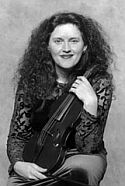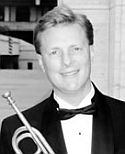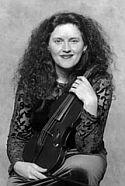
And part, I’m convinced, is Blumenstock’s own love for chamber music. Saturday night’s program at Berkeley’s First Congregational Church — further performances are coming up, Friday in San Francisco and Saturday in Lafayette — used a bigger orchestra than is Blumenstock’s wont on these programs. The concert, titled “Winds and Waves,” was in fact a woodwind showcase, with concertos and suites featuring various wind combinations, and a grand Telemann suite to finish. All the same, the whole concert was shot through with passages of great intimacy.
That was Blumenstock’s canny programming, of course. All six items on the program had movements for the full ensemble of the moment, but others where the texture was radically pared down. In the opening piece, an Overture (No. 6, in G Minor) by Francesco Maria Veracini, that came in the last of the four movements: a Menuet in stark unison for the entire band, skeletal and eerie. Before that, the piece sounded more or less like a normal concerto grosso, except that here the concertino (the solo group) consisted of two oboes and bassoon (Gonzalo Ruiz, Marc Schachman, and Dennis Godburn). For the most part they sat out the tutti sections, playing only when the ensemble hushed itself for their solos. After three movements of this, that gaunt Menuet came as a shock.
Two more Italian concertos followed, and by the time they were over, all but one of the evening’s personnel had gotten a lick in. A Concerto a più instrumenti in E Minor (Op. 5/3), by Evaristo Felice dall’Abaco, turned out to be Corelli-ish, with a lot of short movements (some linked in bigger sections, alternating between two sorts of music) and two outright dance movements (a pair of Passepieds) at the end. Here the stars were flutes (Stephen Schultz and Janet See, the latter switching to piccolo for the first Passepied), while the texture ranged from the full band at frenetic pace to just the two flutes in limpid duet over the barest continuo accompaniment.
In the next concerto, Vivaldi’s D-Minor (RV 566), it got even barer than that. The slow movement was for the recorders (Judy Linsenberg and Hanneke van Proosdij) and bassoon (Godburn) alone, without even the harpsichord (Charles Sherman) and theorbo (David Tayler) that supplemented the bass line elsewhere. The outer movements, though, were prime “kitchen sink” Vivaldi, of the kind PBO does so well, with pairs of oboes and flutes along with the recorders, plus a pair of eager violinists (Blumenstock and Lisa Weiss) raising the rosin dust above everything else.
Vivacious Violin Work
The program’s fourth, last, and by far most familiar concerto was Bach’s Second “Brandenburg,” which opened the second half of the program. John Thiessen
This was a concert designed to feature the PBO winds, so while the four concertos made appropriate side dishes, the entrée really had to be Rameau. Actually it was mostly Rameau — little snippets from Les Indes galantes, Les Fêtes d’Hébé, Zéphyre, Naïs, and Platée, leavened with the storm number from Marin Marais’ Alcione and a sweet bit of birdsong for sopranino recorders from Jean-Féry Rebel’s Les Elemens. The whole shebang was grandly titled “A Suite for Zephyr, Greek God of the West Wind,” and ended the first half. I doubt the little deity ever had so splendid a tribute before.
Dedicated Philharmonia-goers will have heard some of this music before, such as the storm scene from Platée and the delectable “Gavotte pour les Zéphirs et les Nymphes” from Naïs. Still, a lot of it was new to me, and as usual when I hear Rameau I don’t know yet, I was blindsided. It’s all so vivid, so striking, and so plain, gobsmackingly imaginative. There are composers that I, in calmer moments, might love more, but I can’t think of another who repeatedly makes me think, whenever I hear an unfamiliar piece, “There simply is no music better than this.”
Of course, it does help if it’s played this well. I wondered how PBO would fare in this famously finicky stuff without Nicholas McGegan’s amazingly evocative conducting to follow. But the band has been steeped in Rameau for a couple of decades now, and they speak this idiom like ... well, I can’t say “like natives,” since we’ve never heard a native speaker, but like the closest thing to natives that we have hereabouts. It was honed just this side of preciousness (as it has to be), and yet somehow sounded natural.
Heartstoppingly Gorgeous Airs
There’s no point singling out flowers in a bouquet like that, but I have to, in one case. The second of the “Airs pour Zéphire” from Les Indes galantes was a thing of that simplicity and beauty that is somehow heartbreaking. The sole players were Blumenstock, Schultz, and the continuo (cellist Phoebe Carrai joining Tayler and Sherman, as she did most of the night), with Weiss adding another line in the second strain. It was the kind of piece, and performance, in which you were sure that every note lay precisely where it had to be.After the conclave of Zephyrs, a hard act to follow, came Telemann’s Hamburger Ebb’ und Fluth Suite (the title basically means “Hamburg’s Tides,” and it was written to celebrate the centenary of the Hamburg Admiralty in 1723). But Telemann is equal to nearly anything — especially the orchestral-suite-writing Telemann, who even now is little-known, given that most of that music remains unpublished.
The piece isn’t as broadly illustrative as some of the composer’s other programmatic efforts, probably because of the grandeur of the occasion. No chirping crickets or croaking frogs or galloping donkeys are heard here, and for the most part the movement titles (“The amorous Neptune,” “The sleeping Thetis,” and so on) don’t need to be known for a listener to enjoy the music, which is Telemann in his most colorful character-piece vein.
The one exception is the “Gigue: Ebbe und Fluth,” the next-to-last item in the suite, which ingeniously depicts the tide rushing in and then out again. PBO played it with a sweep so broad and impulsive that you hardly had time to notice the detail they gave to every articulation. You were trying not to turn your back on the tide.

